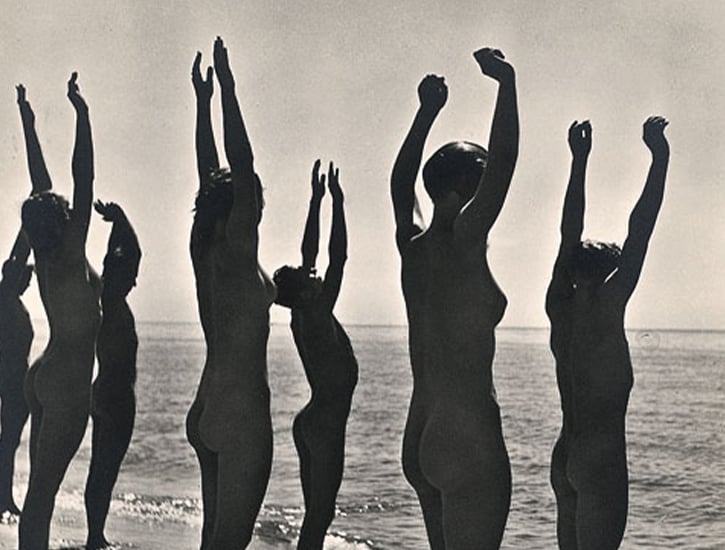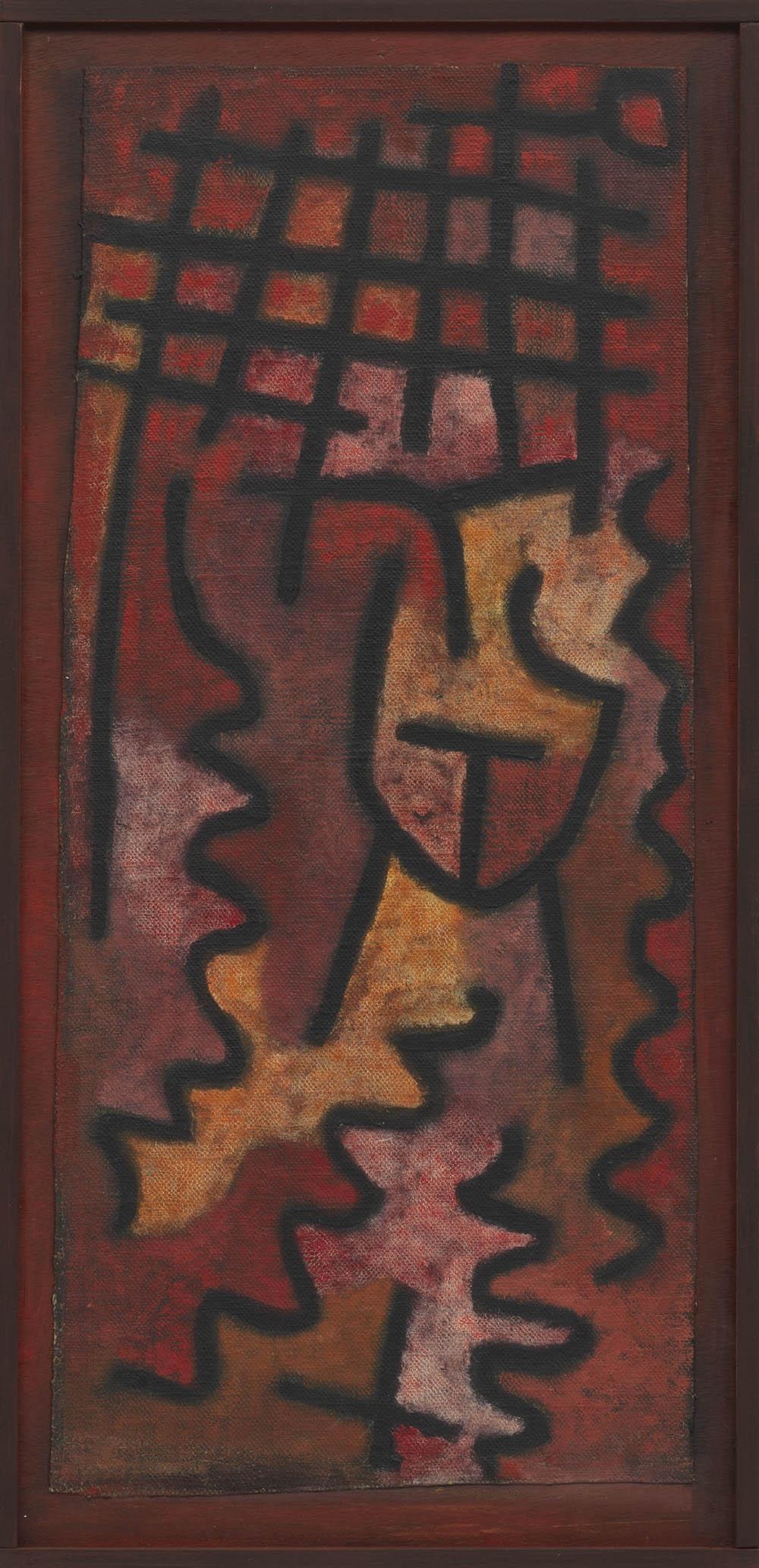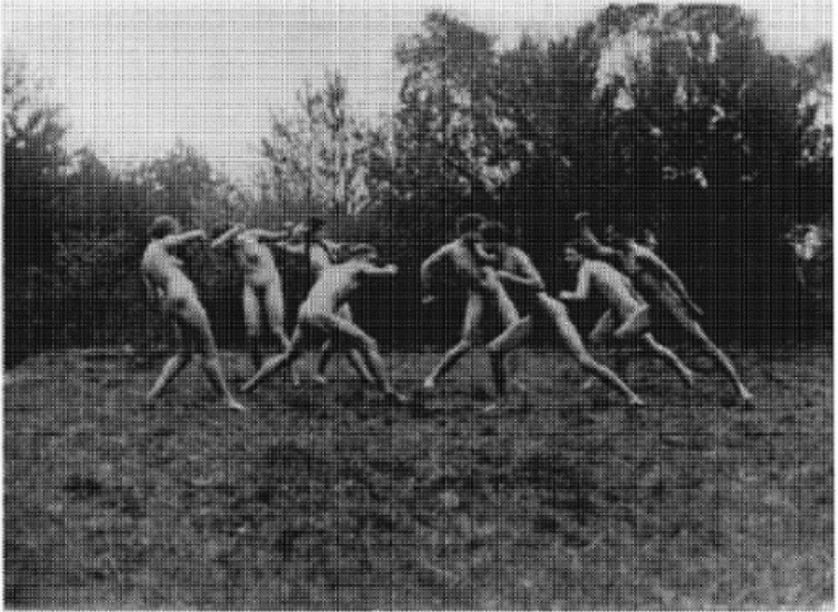Nuding Out
Nuding Out
Politicking in the buff Freikörperkulturin 1920s Germany | apfelauge
Freikörperkulturin 1920s Germany | apfelauge o
r
d
F
a
c
t
o
r
y
In 1926, a crusade swept across Europe. In Germany, Sweden, Switzerland, and even stodgy England, some three million Europeans had reportedly dropped their drawers and flocked to a “nudity cult,” leadingPopular Science Monthlyto ask of its American readers: “Do We Wear Too MuchClothing?” According to writer Robert E. Martin, they had shed tight, heavy garments that scientific experts had declared an impediment to health to swim without bathing suits, run naked over the hills, and perform calisthenics “without a thread of clothing.” Initially, the police tried to cover up all this public nudity, but the practice was spreading so fast that officials were forced to concede, opting only to make arrests when people strolled naked through the city streets. Besides, Martin added, “in the country, or in their clubs, the nudist enthusiasts can treat themselves to as much sunlight as they please.”
Germany was ground zero for Europe’s state of undress. Since the late nineteenth century, thousands of men and women, seeking the salutary benefits of sunlight and fresh air, participated in the famous Freikörperkultur, or “free body culture.” The movement, known by the acronym FKK, took off when bohemian types, rebelling against their parents’ bourgeois mores, started going naked in public. It wasn’t long before diverse groups in German society were stripping down on hikes and at colonies and camps where clothing was verboten. From middle-class office workers who feared the effects of “imprisoning clothes” to protofascists who worshipped classical, bare-chested antiquity, German nudists belonged not to one subculture but many. There were dancers inspired by Isadora Duncan’s nude performances in Berlin and artists like Karl Diefenbach whose oddball milieu included barefoot-walkers and natural healers. In the 1920s, socialist nudists claimed the body as the worker’s own sovereign piece of nature, a buffer against the tensions of industrial modernity. Even municipal authorities warmed to the idea of textilfreirecreation in the well-ventilated outdoors—hiking clubs, “air baths,” and exercise classes—as a possible curative for tuberculosis. Ostensibly unerotic and virtuous, nudism promised to bring Germans closer to “nature” and offered one answer to a pressing question: What did it mean to be healthy in the modern world?

“The misery of our times, the monotony of work, the world war and its legacies, have made us into disturbed human beings, both internally and externally,” wrote Adolf Koch in 1924. Koch was the Karl Marx of nudism, a social critic whose vision for the future would bear fruit in cities across Germany. An elementary school teacher and a solider in World War One, he was wounded and nearly buried alive on the battlefield, fell gravely ill with cholera, and only survived with a permanent disability, like many others of his generation. Between the rise of industrial work and trench warfare, and the food shortages and economic immiseration that followed, the body was under assault, he believed. How could Germans regain control over their own bodies? How could they revitalize their health? In 1923, Koch was hired at an elementary school in Berlin’s Moabit neighborhood, where he hatched a plan to address Germany’s postwar health crisis.
There was nothing sexual about the naked body, nudists believed; it was civilization that sexualized it.
After securing permission from parents and the school inspector, Koch introduced a new extracurricular activity to the school: nudism. The ideas he pitched to parents came from the medical mainstream––before antibiotics and many effective vaccines, German doctors and public health officials subscribed to the holy trinity of fresh air, sunlight, and exercise. Classes in sex-segregated nude gymnastics fixed the “sagging breast, hanging shoulders, and bad posture” and boosted the self-esteem of the boys and girls he taught. Direct sunlight on their skin appeared to cure eczema, prevent rickets, and hasten recovery from infection. “Air and sun are the worst enemies of all proletarian sickness,” Koch’s colleague, Richard Bergner effused, burnishing the image of nudism as modern and scientific.
Clothes were, in Koch’s thinking, unnatural, the mark of civilization’s constraints and the oppressive forces of capitalism. There was utopian potential in stripping away clothing and with it, material and social distinctions. “Nakedness . . . is the democracy of the new Germany,” the protagonist declares in The Temple, a novel by Stephen Spender, set in Hamburg in 1929. For Koch, a dyed-in-the-wool educator, nudism was a more egalitarian form of bildungthat “raises the consciousness of both body and mind.”
Despite the growing popularity of this message, once Berlin’s conservative politicians and Catholic clergy, an aggrieved minority in a left-leaning, majority Protestant city, learned that Koch was teaching boys and girls in the nude, they created an uproar in the press and complained to state officials. Embroiled in scandal, Koch was forced out by the school board—but he was soon able to open his own private school for nudism with help from Dr. Hans Graaz, his physician-collaborator, and financing from donors and subscribers. The school granted teaching certificates accredited by the Weimar government, and was so successful that by late 1920s, there were thirteen branches across Germany. When a pair of curious visitors from New York toured the Hamburg Koch school, they marveled at teenage boys and girls “devoid of clothes,” and “without a symptom of any of the manifold inhibitions so commonly the result of adolescent sex consciousness.” It was thanks to a “Puritanical heritage” that American adolescents couldn’t conduct themselves like young Germans, who radiated “happy health of body and mind.”
German nudists like Koch went to great lengths to “de-eroticize the body,” Maren Möhring, a cultural historian at Leipzig University and an expert on nudism, has said. There was nothing sexual about the naked body, nudists believed; it was civilization that sexualized it. Getting to a person’s essence, or their “authentic” self, required jettisoning all that civilizational garb. German nudists often echoed Goethe, who was rumored to have said: “The only real human is the nude human.”

In his 2007 book, Turning to Nature in Germany: Hiking, Nudism, and Conservation, 1900–1940, historian John Alexander Williams points to the socialist labor movement to explain nudism’s success between the World Wars. For Weimar socialists, “the health of the proletariat was in very dire straits,” and nudism provided a blueprint to “restore the body, the worker’s only real capital,” Williams writes. The Treaty of Versailles abolished compulsory military service in Germany, stoking anxieties about national fitness, which helped make the case for Koch’s schools, where the curriculum was heavy on exercise and also had lessons on health-related topics and the labor movement. The schools were nodes in a growing network of educational and publishing resources for leftist nudists in Germany and beyond, including Koch’s magazine, We Are Naked and Call Ourselves Du (Duas in the informal German you). In 1929, the Berlin Koch school hosted the world’s first International Congress on Nudity, drawing participants from twenty-three countries. The following year, Koch reported that enrollment in nudist organizations in Germany had surpassed three million.
“We exercise in the nude because we can clearly recognize in the body the damages brought by contemporary life,” Koch wrote. For all the talk of building a socialist future, it was exercise and fitness that really mattered, and while structural forces were to blame for Germany’s soaring inequality, it was up to individuals to take control over their own health. Koch urged his readers to ask themselves: “Why have I become so? Are the workplace and the apartment, or my own way of life, at fault?” Sure, Germans could count on health insurance and welfare institutions, Koch reasoned, but only after falling sick. What about staying healthy?
The more nudists promoted a certain vision of health, the more exercise was required to maintain it. “Nudism is part of the genealogy of fitness today,” Möhring says. “It’s the beginning of the fitness movement.” By cultivating the body, forming and making it a certain way—“technologies of the self” in Foucauldian terminology—German nudists practiced self-determination. But it wasn’t just any form of exercise that gave them a sense of agency and control. Nudists attacked sports, the meteoric rise of which was another expression of the health-conscious 1920s, for lacking a holistic approach to body and mind. Whereas sports were about setting records, and privileged certain muscles and movements, nudism appeared to serve the whole person, freeing them from the tyranny of the clock. And yet Koch and his anti-capitalist followers were engaged in a form self-optimization, the pursuit of which had many justifications. They exercised to strengthen the worker’s body—but other German nudists performed the same movements with racial hygiene in mind.
Socialist nudism was part of a “turn to nature,” to borrow Williams’s phrase, in which Germans looked to the environment to imagine a better future. Going naked in the woods promised an escape, at least for a few hours, from the city, with its congestion and cramped quarters. There were also disease outbreaks, including the 1918 flu, which claimed nearly three hundred thousand German lives, many of them young adults living in urban areas. In the aftermath, Germans went in search of green space and fresh air; nudists went even further, exalting nature, its health-giving properties and anti-urban, anti-bourgeois character. But the precise meanings—and ends—of “nature” were all over the map. Environmental historian William Cronon famously wrote that “nature is so often the place where we go searching for the fulfillment of our desires.”
Koch’s movement was eventually shut down by the Nazis, who had their own approaches to the environment, at least in official rhetoric about forest conservation, pollution control, and bringing the Volk closer to nature. Like many Germans, Koch dealt with new regime by adapting to it. After the SA ransacked his school in Berlin, he rebranded as the Adolf Koch League for Social Hygiene, Physical Culture, and Exercise. Williams’s book describes how the Berlin school abandoned its Marxism and “quietly resumed its training courses behind locked doors.” In a (failed) bid to curry favor with the regime, Koch declared “racial biology and racial hygiene are crucial to this struggle for public health,” in a 1934 essay. The following year, the Nazis dissolved the school, condemning its “Marxist elements.” Koch re-opened as the Institute for Eubiotics, and according to Giselher Spitzer, a historian of sports and the author of the only account of the school, it held exercise classes but also served as a refuge where former socialists and trade unionists could meet.
On matters pertaining to nudism, Nazi leaders remained divided, in part because so many nudists shared the regime’s eugenicist ideas, including some socialists. In 1942, Heinrich Himmler, one of the regime’s strongest advocates of nudism (and its most militant homophobe) sanctioned nude bathing in a decree that Williams says helped sustain nudism through the war and contributed to its popularity years later in East and West Germany.
There are an estimated 8 to 12 million nudists in Germany, most of them in the former East and over the age of fifty.
But today, some point to Germany’s shrinking nudist clubs and organizations and see a tradition in perilous decline. Gregor Gysi, a stalwart of the Left party (Die Linke), has invoked a sex researcher, blaming “the pornographic gaze” of West German men” following reunification, as well as greedy real estate developers for gobbling up beaches and lakefront properties where nudists once congregated. There is nothing erotic about the naked body: “A bikini can be much more erotic than FKK,” Gysi said in a Playboyinterview, sounding just like the nudists of a century ago. The generation that came of age under the German Democratic Republic, to which Gysi belongs, cherishes memories of nude bathing in the Baltic, a form of leisure that wasn’t co-opted by the state, like everything else. The practice was banned, but East German sunbathers refused to comply, and the state caved in 1956, legalizing nudism. Today, nudism is mostly recreational, rather than an organized practice with political intent. There are an estimated 8 to 12 million nudists in Germany, most of them in the former East and over the age of fifty.
Most cities, at least in Germany’s Protestant north, have long maintained dedicated areas in public parks for stripping down, and FKK signs aren’t difficult to spot along Germany’s northern coastline either. “There’s a tradition, and I think it’s still important at the moment,” Möhring says, “that specific concepts of naturalness are highly esteemed in Germany.” Among Berlin’s few remaining clubs is the Adolf Koch Family Sport Club, where members can take up nude yoga, sports, swimming, and gymnastics or enroll in “body awareness” classes. Unlike the Koch schools of the twentieth century, nudity is not always required, and shoes, sports bras, and kneepads are always welcome.
“Within the nudist idea in Germany, there’s so much in it, so many norms,” Möhring says, “an idea of what the human being is and how he acts.” In recent years, body piercings and tattoos have been a source of controversy at nudist clubs across Germany, where all body art was prohibited and deemed “unnatural,” or a ploy to draw attention to certain parts of the body. Eventually, facing an uphill battle, the clubs relented. These episodes “demonstrate that the idea of naturalness changes; it’s not the same anymore,” says Möhring, who is now dissecting German debates over women bathing in burkinis at swimming pools. What’s “natural” is always historical––even when it comes to the human body, it depends on the time and the place.
本文地址:http://panshare.cn/zhishitisheng/2019/0731/1023.html
版权声明
本文仅代表作者观点,不代表本站立场。
本文系作者授权发表,未经许可,不得转载。